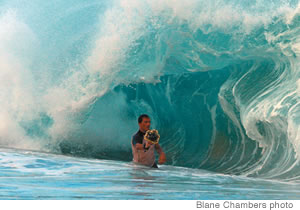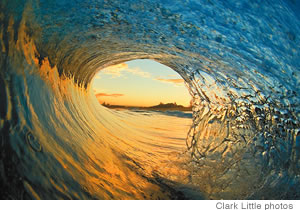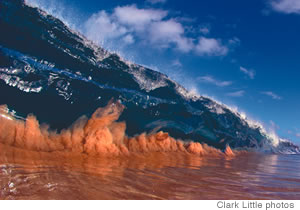taking wave
Clark Little, a former pro surfer turned photographer, shoots spellbinding images of waves that capture the power and beauty of the sea. This week he opens a downtown exhibition of his dramatic work

By .(JavaScript must be enabled to view this email address)
E-mail this story | Print this page | Archive | RSS

|
The afternoon scene is straight off a Hawaiian postcard: Clear skies, warm sunshine, green palm trees and sand kept cashmere-smooth by the white froth of ocean waves.
On a hidden beachfront paradise, Clark Little looks out over his domain and dives headfirst into the pounding winter surf. As the winds kick up and the wave faces start to grow, he unabashedly travels farther out and straight into the tubes.
When Clark finally travels back in with the current, he surveys the surf and states, “Too bad. The waves this morning were so glossy. Now they’re getting choppy.” After a short pause, he adds, “The lighting was better in the morning, too.”
So what’s lighting got to do with catching a wave? Well, for this former pro surfer turned photographer, everything.
Although born in Napa, Calif., Clark and his family moved to the North Shore of Oahu when he was 1. He grew up in the heart of beach-boy culture, so it’s no surprise to hear he’s been surfing nearly all his life. A graduate of Waialua High School, Clark says he dabbled in a little of everything - even taking a tour of Mexico and California during his professional surfing days in the late ‘90s - before settling into his “main job” as a a supervisor for the City and County of Honolulu at Wahiawa Botanical Garden 17 years ago. When he’s not busy overseeing 27 acres of tropical plants and other foliage from all over the world, he’s probably down at the beach getting shots of the barren surf.
“It’s more of a passion, a hobby, but if it evolves into something, great!” he exclaims, chuckling that when winter rolls around, he can easily drop as much as 30 pounds during his hours-long photo sessions. “I love to be in the ocean; I feel like a dolphin. Just to be swimming in the ocean is awesome, you know, with waves crashing down. And to get the images on top of that is insane.”

Clark has only been on the photog scene for a year. His father was a photography teacher at Leeward Community College for 22 years, but Clark says he learned how to point and shoot from pro surf photographer Brian Bielmann.
“He basically told me what to buy: what housing to get, what camera to get, what lens to get,” Clark remembers. “I bought the stuff, went to him and said, ‘OK, what do I do?’ We sat there for hours and set it up, the whole nine yards, and he got me ready to go out there. Fortunately I got tipped off by an expert. It could have taken me five, 10 years through trial and error, but he told me the prime way to set it for surf photography. And that gave me a huge advantage to just go out there and basically pull the little trigger.”

Some of his favorite places to capture are Waimea and Ke’ike shores - they have explosive yet serene atmospheres, the same attributes to look for when paddling out. When Clark heads out, it’s just himself, his camera and Mother Nature; however, he says working a 6-inch lens is easier than a 6-foot board.
“It’s hard to explain,” he begins, stopping to consider how best to get his angle across. “When you surf, if you take off and you eat it, you’re committing yourself for that wave. When you’re taking pictures, you can shoot the pictures in the tube and sneak out the back of the barrel and not get the over-the-falls effect.
“From surfing before, that gives me an advantage because I know the ocean, I know where
Page 1 of 2 pages for this story 1 2 >
E-mail this story | Print this page | Comments (0) | Archive | RSS
Most Recent Comment(s):








